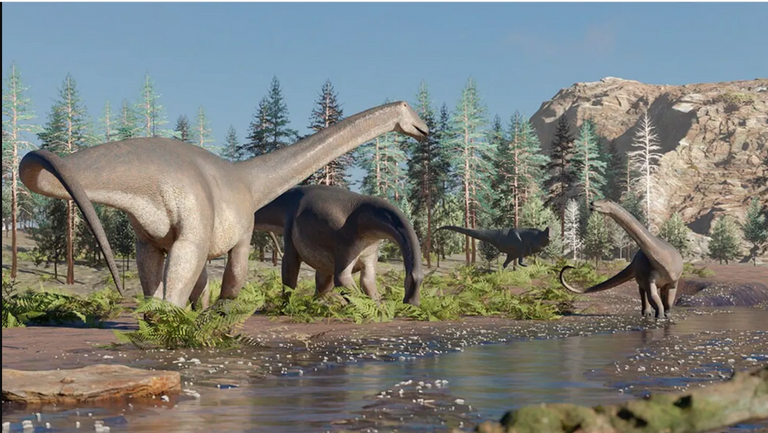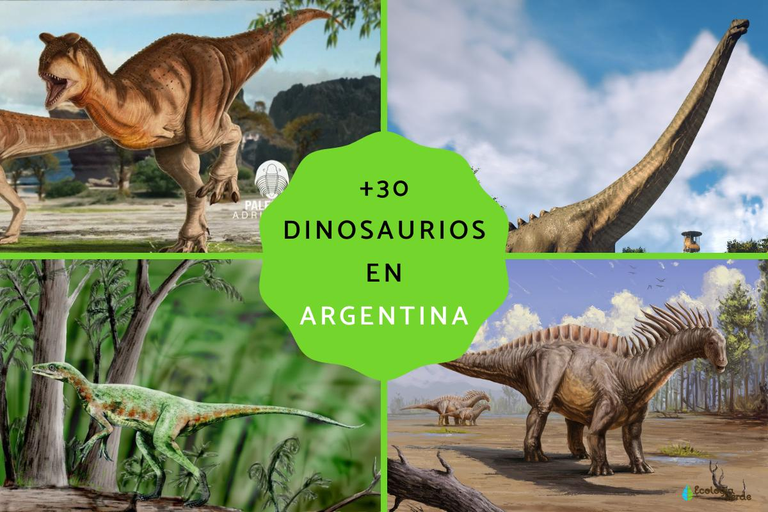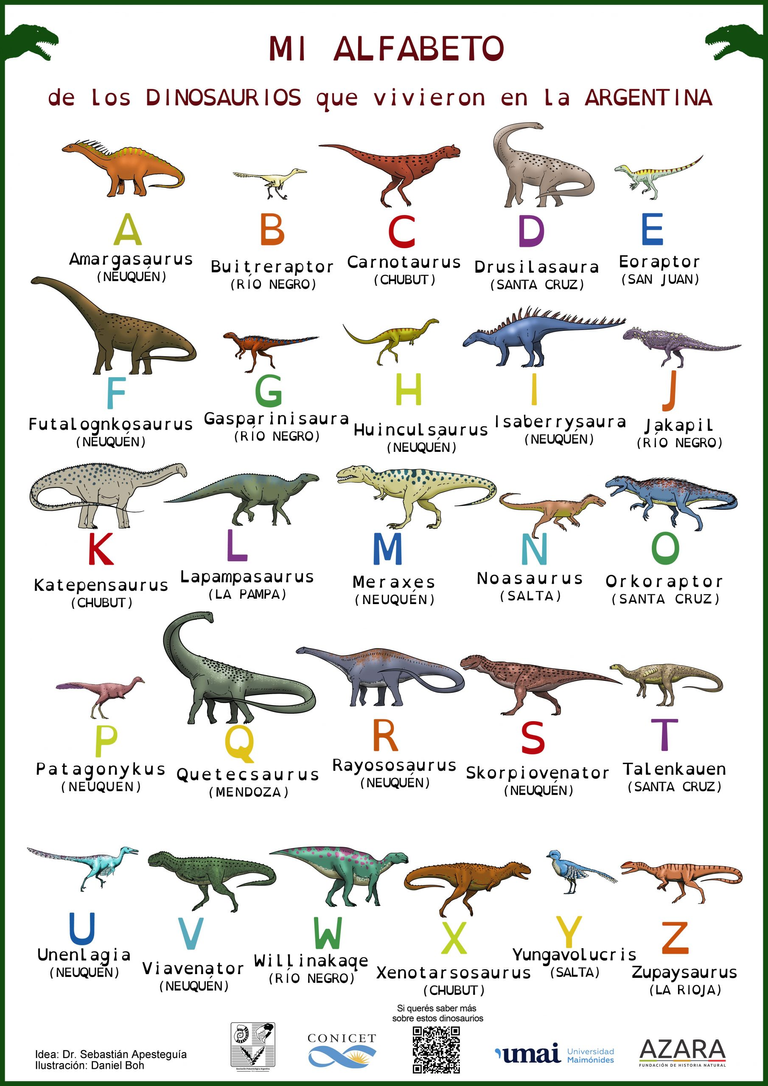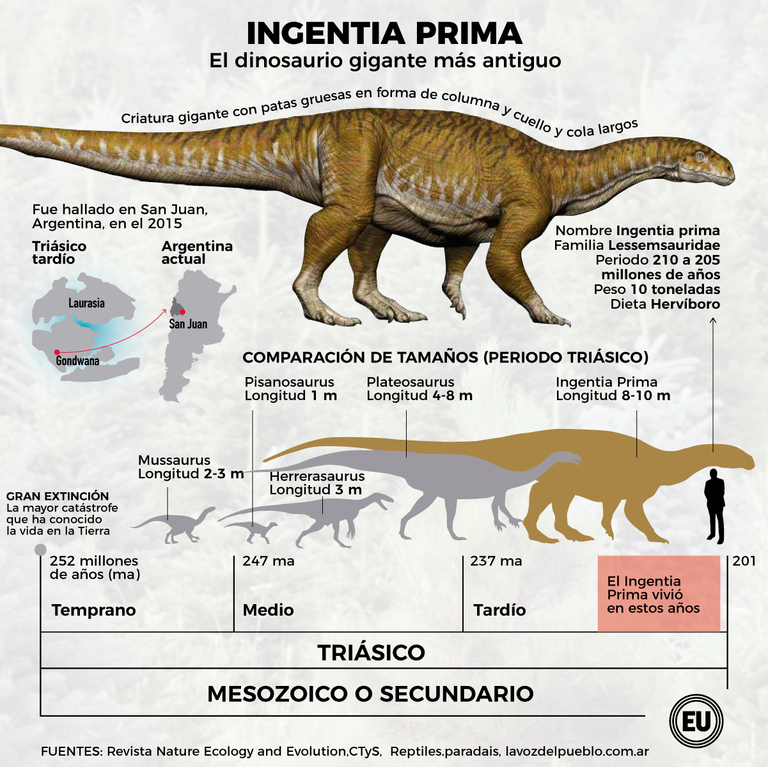
Argentina has proven to be, through the paleontological findings of Argentine dinosaurs, the promised land of scientists, paleontologists and lovers of the great saurians that once, more than 65 million years ago, absolutely dominated the planet for a period of time of more than 160 million years.
In prehistoric times, Argentina was a place heavily populated by dinosaurs. At present, the discovery of fossil remains has attracted the attention of paleontologists from all over the world, as well as tourists from Argentina and abroad.

Argentina ha demostrado ser, a través de los hallazgos paleontológicos de dinosaurios argentinos, la tierra prometida de científicos, paleontólogos y amantes de los grandes saurios que alguna vez, hace más de 65 millones de años, dominaron de manera absoluta el planeta por un período de tiempo de más de 160 millones de años.
Argentina fue en la prehistoria, un sitio muy poblado por dinosaurios. En la actualidad, el hallazgo de restos fósiles ha despertado la atención de paleontólogos de todo el mundo, así como de turistas del país y del exterior.
Parallel to the changes in living species, there were also great geographical and climatic changes. At that time, there was a single continent on the planet, known as Pangea. The Andes Mountain Range had not yet formed, allowing the sea to reach the present province of Neuquén.
Later, the waters receded, leaving large lakes and lush vegetation in their wake, providing an ideal habitat for the development of dinosaur life. During the Jurassic period, the giants lived peacefully feeding on the forests of conifers and large trees such as araucarias. With the formation of the Andes Mountains in the Tertiary, a second invasion of the waters from the Atlantic Ocean took place.
This was particularly important for the current work of paleontologists, since the sedimentation processes, after these two invasions of maritime waters, contributed to favor the preservation of fossil remains. It is believed that sedimentation processes are the key to the preservation of fossil remains.
100 million years ago, the Patagonian territory consisted of grasslands populated by forests interspersed by rivers and streams. The Andes Mountains did not exist, although there were active volcanoes. The Pacific Ocean reached this territory. With this soil and geographical characteristics, the climate at that time was tropical or humid subtropical.
Among the Cretaceous vegetation, there were species of araucarias, ginkos and other primitive rarities. There were ferns under the trees, cycads and the first flowering plants made their appearance. During this period lived the largest carnivore ever found, the Giganotosaurus Carolini, whose dimensions were about 14 meters long.
In the same environment, it coexisted with smaller carnivores and herbivores, especially the Andesaurus Delgadoi. Aquatic turtles, predecessors of today's turtles, and small primitive mammals, as well as flying reptiles, such as the pterosaur, and insects such as dragonflies, although larger than those existing today, together with invertebrates, were part of the prevailing ecosystem.
In the province of Neuquén, for example, some 30 sites with fossil remains have been found in the course of the last three decades. Some 40 dinosaur species have been identified in the provinces of Salta, San Juan, especially in the Valle de la Luna (Ischigualasto), San Luis, Mendoza, La Rioja, Chubut, Neuquén, Río Negro, Santa Cruz and even in Antarctica.
This would represent approximately 10% of the total number of species that have been found around the world so far. This gives us the guideline of the worldwide paleontological relevance of Argentina in terms of prehistoric findings and as the cradle and primitive ecosystem of dinosaurs.
Throughout Patagonia, there are numerous frolil, "stone bones", the name given to fossil remains by the native Mapuche people.

Paralelamente a los cambios acontecidos en las especies vivientes, también se produjeron grandes cambios geográficos y climáticos. Existía, en aquellos tiempos, un continente único en el planeta, conocido como Pangea. La Cordillera de los Andes no se había formado aún, permitiendo que el mar llegase hasta la actual provincia de Neuquén.
Más tarde, las aguas retrocedieron dejando a su paso grandes lagos y una vegetación exuberante, constituyendo un hábitat ideal para el desarrollo de la vida de los dinosaurios. En el transcurso del período Jurásico, los gigantes vivieron tranquilamente alimentándose de los bosques de coníferas y grandes árboles como las araucarias. Con la formación de la Cordillera de los Andes, en el terciario, se produjo una segunda invasión de las aguas procedentes del Océano Atlántico.
Esto fue particularmente importante para el trabajo actual de los paleontólogos, pues los procesos de sedimentación, luego de esas dos invasiones de las aguas marítimas, contribuyeron a favorecer la conservación de los restos fósiles. Se cree que en los procesos de sedimentación estaría la clave para la conservación de los restos fósiles.
Hace 100 millones de años, el territorio patagónico consistía en praderas pobladas por bosques entrecortados por ríos y arroyos. La Cordillera de los Andes no existía, aunque si había volcanes activos. El océano Pacífico llegaba hasta este territorio. Con este suelo y características geográficas, el clima que se presentaba entonces era tropical o subtropical húmedo.
Entre la vegetación del Cretácico, se observaban especies de araucarias, ginkos y otras rarezas primitivas. Había helechos bajo los árboles, cicas y las primeras plantas con flores hacían su aparición. En ese período vivió el carnívoro más grande hallado hasta el momento, el Giganotosaurus Carolini, cuyas dimensiones eran de unos 14 metros de longitud.
En el mismo medio, convivía con carnívoros de tamaño menor y herbívoros, destacándose el Andesaurus Delgadoi. Las tortugas acuáticas, antecesoras de las actuales, y mamíferos pequeños primitivos, así como reptiles voladores, ejemplo de ello era el pterosaurio, e insectos como libélulas, aunque de mayor tamaño que las existentes hoy en día junto a invertebrados, componían parte del ecosistema reinante.
En la provincia de Neuquén, por ejemplo, se hallaron unos 30 sitios con restos fósiles en el transcurso de las últimas tres décadas. Se han identificado unas 40 especies de dinosaurios distribuidas en las provincias de Salta, San Juan es-pecialmente en el Valle de la Luna (Ischigualasto), San Luis, Mendoza, La Rioja, Chubut, Neuquén, Río Negro, Santa Cruz y hasta en la Antártida.
Esto representaría, aproximadamente, un 10% del total de especies que se han hallado alrededor del mundo, hasta el momento. Lo cual, nos da la pauta de la relevancia paleontológica de nivel mundial que acredita Argentina, en materia de hallazgos prehistóricos y como cuna y ecosistema primitivo de dinosaurios.
A lo largo de toda la Patagonia, son numerosos los frolil, "huesos de piedra"; denominación que el pueblo autóctono de los mapuches le otorgó a los restos fósiles.

Source images / Fuente imágenes: CONICET.
Telegram and Whatsapp
Thanks for supporting, curating and voting for my content @techclub.
Upvoted. Thank You for sending some of your rewards to @null. Get more BLURT:
@ mariuszkarowski/how-to-get-automatic-upvote-from-my-accounts@ blurtbooster/blurt-booster-introduction-rules-and-guidelines-1699999662965@ nalexadre/blurt-nexus-creating-an-affiliate-account-1700008765859@ kryptodenno - win BLURT POWER delegationNote: This bot will not vote on AI-generated content
Thanks!